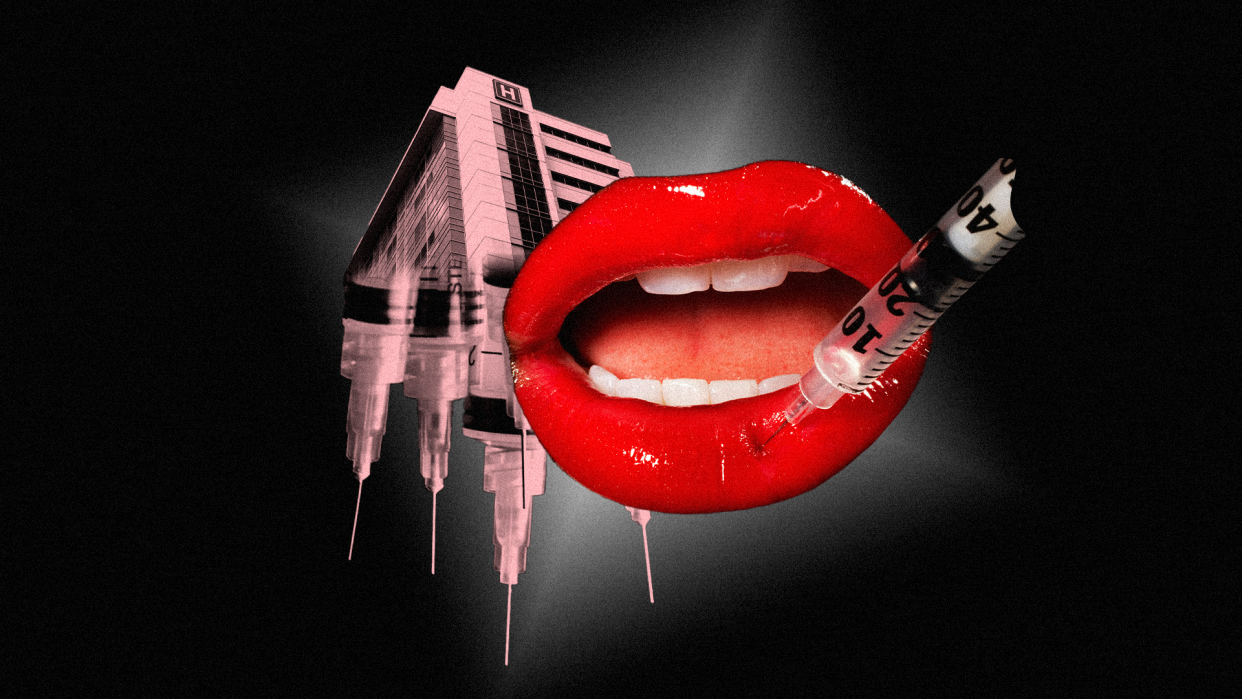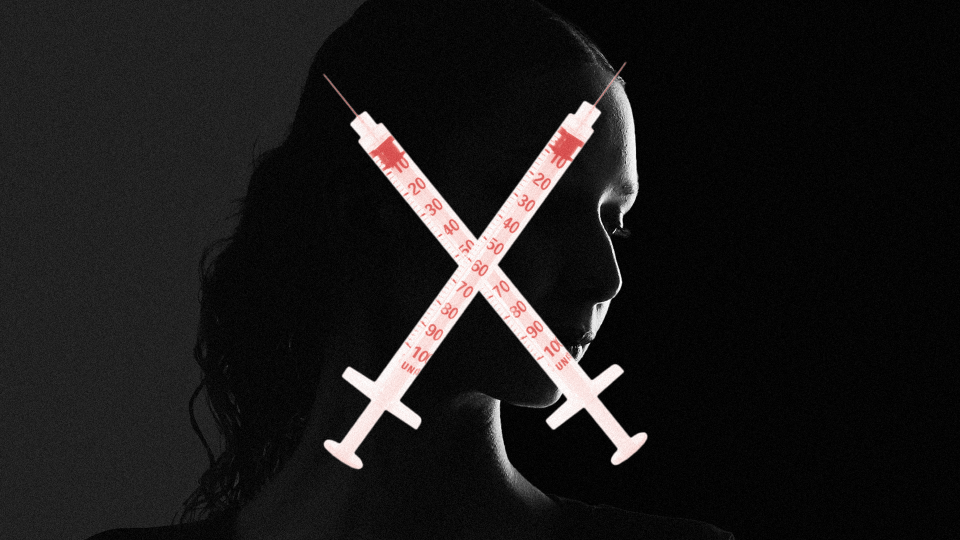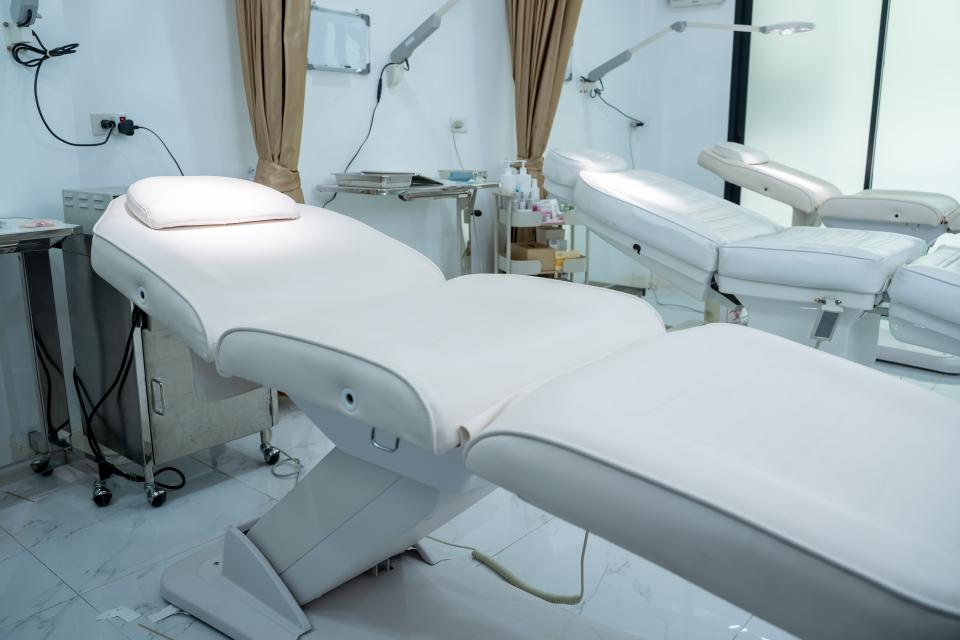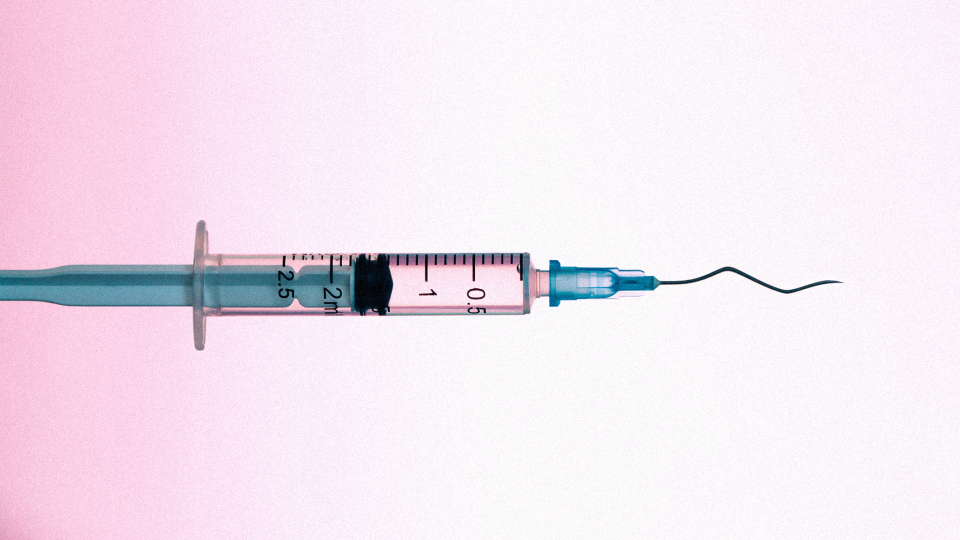Want Cosmetic Injections? Please Don’t Go to That Shady Med Spa

Collage: Channing Smith. Photography: Getty Images
As someone who’s spent the last four years researching and reporting on the rise of cosmetic injections, the influx of young women getting them, and the subsequent rise and normalization of aesthetics procedures among all ages and genders, I am begging you to listen: Please, don’t ever go to a shady med spa just because it’s cheaper.
For one, injections are inherently risky—full stop. No matter how invincible you may feel. “Anytime a needle punctures the skin, there’s always a risk of bruising, swelling, and infection,” says Kristina Kitsos, RN, a Beverly Hills nurse and cosmetic injector with 19 years of experience. While neuromodulators (think Botox and Daxxify) and fillers (such as Restylane and Juvederm) are mostly considered safe in terms of serious adverse effects, this is only the case if the injector knows what they’re doing. And is actually licensed to perform injections.
“Anything that involves blood and needle injections are medical procedures, and acquiring FDA-approved drugs requires a medical license,” says board-certified cosmetic dermatologist Paul Jarrod Frank, MD, who says there are some delegable medical health care professionals that can perform certain procedures other than doctors, like registered nurses (RNs), nurse practitioners (NPs), and physician assistants (PAs). “In some states estheticians can perform certain laser and device treatments, but in no state that I’m aware of can estheticians use blood products or inject things into people,” he adds.
This is because things can go wrong with injections. For one, inexpert Botox injections can cause ptosis—drooping eyelids which have no immediate cure and must be waited out. Poorly injected filler, on the other hand, can puncture and constrict blood vessels. “Called vascular occlusion, this can result in a number of different and very serious problems, like pulmonary embolism and tissue necrosis,” says Kitsos. (Necrosis is the death of skin cells and is what causes gangrene.)
Faulty undereye filler can also cause blindness, while Botox can result in cornea problems and bleeding behind the eye in some rare cases, per the brand’s website. That said, it should be noted that these complications are much more rare when legitimate products are administered by qualified injectors. For example, ptosis, one of the less extreme and technically more frequent adverse Botox reactions, only impacts 5% of patients, though that number drops to 1% if a “skilled doctor does the injection,” according to WebMD.
Many people pursuing cosmetic injections don’t realize the risks, though: As aesthetics rise in popularity, so does its presence on social media, where users can edit their less-than-Instagrammable realities. “Social makes it look quick and easy, like going to the hair salon for a blowout,” Kitsos says. “What they often don’t show is the downtime, pain, bruising, swelling, and adverse reactions or side effects that are a very real part of aesthetic medicine. Plus, many people have the ‘it won’t happen to me’ mentality."
If a droopy eyebrow is the best-case scenario from brand-name Botox gone awry, what happens if you’re injected with counterfeit Botox, or your injector uses contaminated needles? It might seem outlandish and like something that wouldn’t happen today, but the past month has proven that the these scenarios aren’t just possible, but are becoming a serious problem with increasingly dire consequences.
In fact, Glamour interviewed one of the 19 women who became ill after unknowingly being treated with fake Botox by an unlicensed Med Spa in 2024. She and eight others were so sick they had to be hospitalized. Five of the affected women tested positive for botulism, while Glamour’s anonymous source was clinically diagnosed. That said, not everyone realizes they have botulism in time to test, so there very well may have been more.
It Happened to Me
“The next day I woke up and my arms had fully stopped working. They were pretty much in paralysis.”
“I really thought I was going to die. I wouldn’t wish it on my worst enemy,” the source said of her experience, describing it as “traumatic” and “the worst three months of my life.” Still, she considers herself lucky. According to her toxicologist, if she had been injected with any more units of counterfeit Botox, she “would probably be in the ICU on a ventilator.”
Above all, she is grateful she doesn’t have a lifelong disease or condition. But the same can’t be said for all of the other victims. Less than two weeks after the CDC made the announcement about fake Botox, three New Mexico women contracted HIV after receiving “vampire” facials performed with contaminated needles.
While HIV transmission from contaminated blood through unsterile injection is generally a well-known risk, the vampire facial victims are the first documentation of infection involving cosmetic services, according to Rachel Westbay, MD, board-certified dermatologist at New York City’s Marmur Medical.
“It’s extremely uncommon for that to happen,” says Kitsos. “The spa had to have been cutting ridiculous corners—literally saving pennies.”
News
Here’s what we know.
All victims were pursuing their procedure of choice for “cosmetic” reasons and were administered by underqualified injectors and facialists at either unlicensed spas or “nonmedical settings,” such as Botox parties or in someone’s private home. Glamour’s anonymous source received her fake Botox from a med spa in New York City that was “advertised as licensed and looked so legitimate.”
The most glaring question is: How are places getting away with this? It all goes back to the rise in cosmetic injections overall. There are plenty of social, emotional, and mental health implications that can stem from seeking injections, especially as artificial intelligence and photo-editing software continues to blur the line between what’s real and what’s attainable. But what’s worst and most imminently dangerous of all is how unlicensed injectors and med spas are willing to profit off those insecurities…while actively putting patients’ health and safety at risk.
“It’s simple economics: Where there is demand, there will be a supply, and there has never been more demand for cosmetics.”
—Rachel Westbay, MD
“It’s simple economics: Where there is demand, there will be a supply, and there has never been more demand for cosmetics,” Dr. Westbay says of the rapid rise of unqualified med spas. “Our society is growing increasingly more vain, which is, at least in part, attributed to social media. Beauty standards are becoming warped and nearly unattainable owing to the use of filters and photo-editing apps, which has people running to injectors in the hopes of attaining these new ideals.”
Of course, people have always been vain in some way or another; Marilyn Monroe’s skin care routine is still being published, after all. But injections are a different beast altogether: They grant instant gratification via needle, which unlicensed med spas make “accessible” by lowering the cost. The trade-off is, obviously, the patients’ health, their safety, and even their lives: Botulism can be fatal in 5% to 10% of cases, per the World Health Organization.
Health News
The FDA and the CDC are investigating claims of counterfeit Botox in nonmedical settings. Here's what you need to know.
“It’s a reflection of the general boom of the industry,” says Dr. Frank. “You have more people that desire getting treatments because of the accessibility, commonality, and acceptance of it, and people of all socioeconomic groups seeking them. With many things, cost is a major issue, and it’s generally expensive to pay health care professionals at any level, from legitimate med spas to board-certified doctors.”
That’s not necessarily because patients want to see someone unlicensed, though; it’s merely a cost-cutting measure. “In order to be relatively competitive against highly trained specialists, unlicensed injectors need some other appeal besides academic pedigree—hence, cost reduction,” Dr. Westbay says. “There is also a possibility that the product they are using is unlicensed and obtained at a cheaper consumable fee for the injector. With a lower consumable, the cost of product can be lowered.”
Also of note? Kitsos says patients have brought her various vials and bottles and asked her to inject them, which she’s refused. “Just like knock-off handbags, there are a lot of counterfeit injectables out there,” she says. Of course, the difference is that a fake Birkin doesn’t historically kill people.
While master injector has become a popular term for injectors online, there are no actual classes or certifications that any doctor or nurse can take to certify themselves as one.
As for how to ensure you’re getting brand-name cosmetic injections from someone who’s qualified? For one, don’t let yourself be fooled by social media. “There are many accounts with huge numbers of followers that are run by people who are not licensed,” says Kitsos.
While master injector has become a popular term for injectors online, are no actual classes or certifications that any doctor or nurse can take to certify themselves as one, according to Dr. Westbay. “Anyone can choose to write this on their website since it is not a legally regulated term,” she says, noting that those who really are “master injectors” don’t usually write that claim it on social media as they can cite their actual qualifications instead.
“It’s this line of thinking: They have a ton of followers so they must be really talented, right? or They must have so many followers because they’re really well-known in the industry. But that’s all a facade,” says Dr. Westbay.
“Likes on social media do not correlate with diplomas on the wall, experience, or expertise,” Dr. Frank reiterates, as proven by Glamour’s anonymous source. She went to an unlicensed med spa, which had an Instagram account with lots of real followers, while her injector identified himself as licensed. And she’s still suffering from botulism symptoms three months later.
“Anyone can call themselves anything, and the only real, valid qualification to do injectables is a license in the state in which the injector is practicing,” says Kitsos. “Whether it be a medical, nurse practitioner, registered nurse, or physicians assistant license, having one of these licenses is not negotiable and should be the very first thing that people look for in an injector.”
This is especially important if your injector is at a “Botox party.” According to Kitsos, an unlicensed injector was caught illegally injecting patients with unverified substances at a popular Los Angeles hotel and only accepted cash payment. “If your practitioner is injecting you in hotel rooms and only accepting cash, that is a huge red flag,” Kitsos says.
Another bad sign? “If they are injecting you with products that are not in a single, sterile container and instead pouring out products into a cup and sucking it up with a syringe,” she says.
At the end of the day, you need to put yourself and your health first—even if that means forgoing cosmetic injections or paying more than you’d like for them. “People prioritize their vanity so much that they are knowingly or subconsciously blind to the risks,” says Dr. Westbay, who likes to remind clients: You are not purchasing a syringe of Botox; you are purchasing the skill and expertise of the person administering it.
You are not purchasing a syringe of Botox, you are purchasing the skill and expertise of the person administering it.
That’s why it’s imperative to see a trusted, licensed health care professional. “You can ask them for their license number, and look them up online and verify whether they actually have a license,” says Kitsos. “This is public information.”
To find a licensed injector, search for board-certified dermatologists and plastic surgeons via the website of the American Academy of Dermatology or the American Society of Dermatologic Surgery. You can also use RealSelf, which verifies doctors’ medical licenses every three months and lists their board certifications so you can easily find what they’re certified in and features unedited before-and-after photos.
Once at your appointment, make sure you’re in a clean environment and ask to see consent forms, ensuring you have time to read and sign them. “Make sure someone explains your risks and benefits and that someone is available for questions,” says Dr. Frank. “If you want, you can ask to see the vials, the injectables, or the needles that are opened. These are not outlandish requests in a world where we’re worried about these type of risks.”
Finally: “Don’t price-shop from the bottom. You do get what you pay for to some degree,” Dr. Frank concludes. “You don't have to go to the most expensive person, but if something seems extraordinarily cheaper than anywhere else, you have to consider that a red flag and find out why.”
Danielle Sinay is the associate beauty editor at Glamour. Follow her on Instagram @daniellesinay.
Originally Appeared on Glamour




